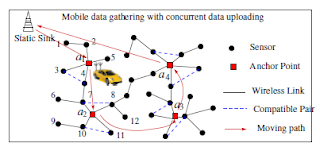Abstract
Data
uploading time constitute a large portion of mobile data gathering time in
wireless sensor networks. By equipping multiple antennas on the mobile
collector, data uploading time can be greatly shortened. However, previous
works only treated wireless link capacity as a constant and ignored power
control on sensors, which would significantly deviate from the real wireless
environments. To overcome this problem, in this paper we propose a new data
gathering cost minimization framework for mobile data gathering in wireless
sensor networks by considering dynamic wireless link capacity and power control
jointly. Our new framework not only allows concurrent data uploading from
sensors to the mobile collector, but also determines transmission power under
elastic link capacities. We study the problem under constraints of flow
conservation, energy consumption, elastic link capacity, transmission
compatibility and sojourn time. We employ the subgradient iteration algorithm
to solve the minimization problem. We first relax the problem with Lagrangian
dualization, then decompose the original problem into several sub problems, and
present distributed algorithms to derive data rate, link flow and routing,
power control and
transmission
compatibility. For the mobile collector, we also propose a sub algorithm to
determine sojourn time at different stopping locations. Finally, we provide
extensive simulation results to demonstrate the convergence and robustness of
proposed algorithms. The results reveal 20% shorter data collection latency on
average with lower energy consumptions compared to previous works as well as
lower data gathering cost and robustness in case of node failures.
Aim
The
main aim is to generate a new data gathering cost minimization framework for
mobile data gathering in wireless sensor networks by considering dynamic
wireless link capacity and power control jointly.
Scope
The
scope is to employ the subgradient iteration algorithm to solve the
minimization problem. And then the problem with Lagrangian dualization, then
decompose the original problem into several sub problems, and present
distributed algorithms to derive data rate, link flow and routing, power
control and transmission compatibility. For the mobile collector, it also provide
a sub algorithm to determine sojourn time at different stopping locations.
Existing System
Wireless
sensor networks (WSNs) play an increasingly important role in a wide range of
applications, e.g., wildlife tracking, habitat monitoring and battlefield
intelligence. These applications usually involve hundreds or even thousands of
sensor nodes powered by batteries with limited energy over a large field.
During the operation, sensors organize themselves into a network and report
sensing data to the sink(s) periodically. How to aggregate data from sensors
largely determines the energy consumptions of the network. In recent years,
extensive research efforts have been devoted to data gathering in WSNs. Most of
them focused on static data gathering where sensing data is gathered by a
static sink. In an optimal routing and data aggregation scheme for WSNs was
proposed to maximize network lifetime by jointly optimizing data aggregation
and routing.
Disadvantages
Data
uploading time constitute a large portion of mobile data gathering time in
wireless sensor networks. By equipping multiple antennas on the mobile
collector, data uploading time can be greatly shortened. However, previous
works only treated wireless link capacity as a constant and ignored power
control on sensors, which would significantly deviate from the real wireless
environments.
The
problem is of tree construction for maximizing network lifetime with a single
base station in the network. Energy efficient and collision-free polling
schedules in multi-hop clusters to reduce energy consumption. However, these
schemes suffer from the notorious energy hole problem in which the neighboring
nodes closer to the sink consume more energy due to relaying more data. The
congested area around the sink could easily cause service interruptions or
packet loss that can severely degrade network performance.
Proposed System
We
propose a comprehensive data gathering cost minimization (DaGCM) framework. We
first define data gathering cost with respect to the amount of data a sensor
uploads to anchor points. Then we minimize the total data gathering cost by
integrating the constraints of flow conservation, energy consumption, elastic
link capacity and compatibility required by MIMO transmission and bound of the
total sojourn time into one optimization problem. Upon discovering the original
problem is non-convex, we convert it into a convex one by introducing auxiliary
variables and logarithmic transformation. By applying Lagrangian dualization,
we decompose the problem into several subproblems. We further provide
distributed cross-layer subalgorithms to calculate data rates, link flow and
transmission power for each sensor as well as sojourn time at different anchor
points for the SenCar. Our numerical results reveal that the proposed
algorithms can converge to the optimum in about 50 iterations. We also conduct
extensive simulations to show that our framework can significantly reduce data
gathering time and total energy consumption compared to the algorithms without
concurrent data uploading and power control.
Advantages
· This
is the first work to explore optimal solutions with concurrent data uploading
given the selection of anchor points. To the best of our knowledge, this is
also the first work that integrates elastic link capacity and transmission
power control into an optimization problem using MIMO communications in WSNs.
· This
project not only allows concurrent data uploading from sensors to the mobile
collector, but also determines transmission power under elastic link
capacities.
System Architecture
SYSTEM CONFIGURATION
HARDWARE REQUIREMENTS:-
· Processor - Pentium –III
· Speed - 1.1 Ghz
· RAM - 256 MB(min)
· Hard Disk - 20 GB
· Floppy Drive - 1.44 MB
· Key Board - Standard
Windows Keyboard
· Mouse - Two or Three Button Mouse
· Monitor - SVGA
SOFTWARE REQUIREMENTS:-
·
Operating
System : Windows 7
·
Front
End :
JSP AND SERVLET
·
Database :
MYSQL
References
Songtao
Guo , Yuanyuan Yang “DAGCM: A CONCURRENT DATA UPLOADING FRAMEWORK FOR MOBILE
DATA GATHERING IN WIRELESS SENSOR
NETWORKS” INFOCOM,
2012 Proceedings IEEE.

No comments:
Post a Comment